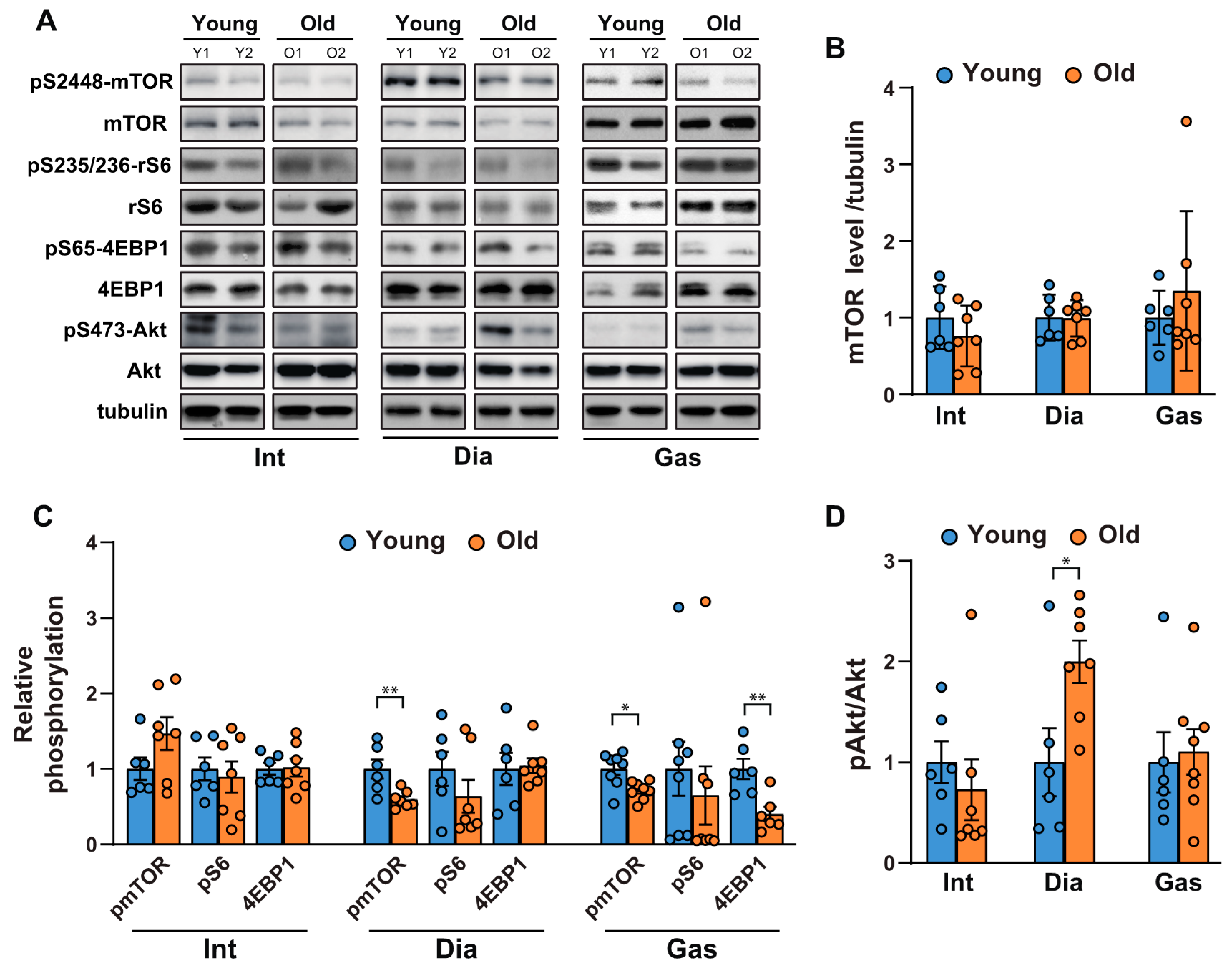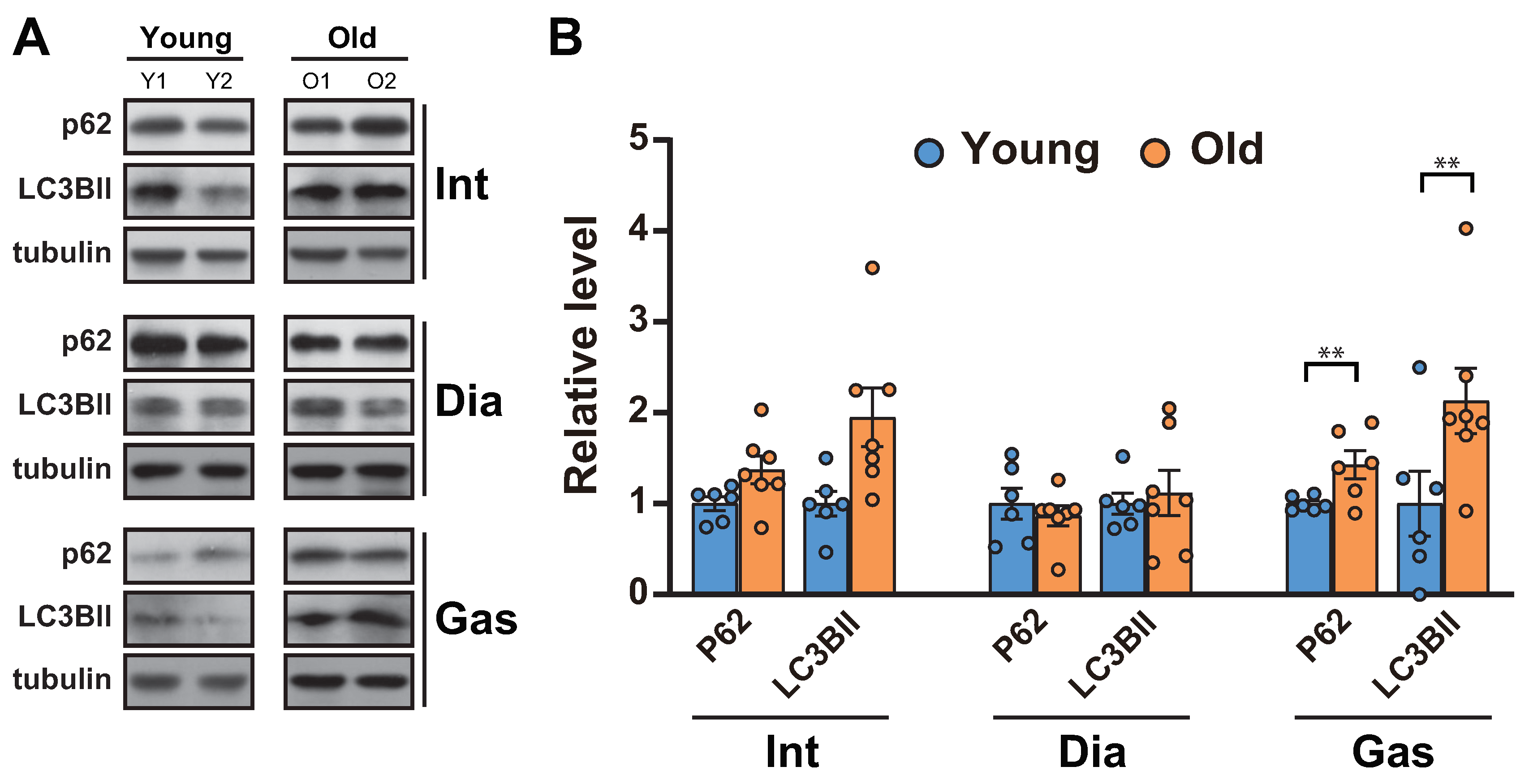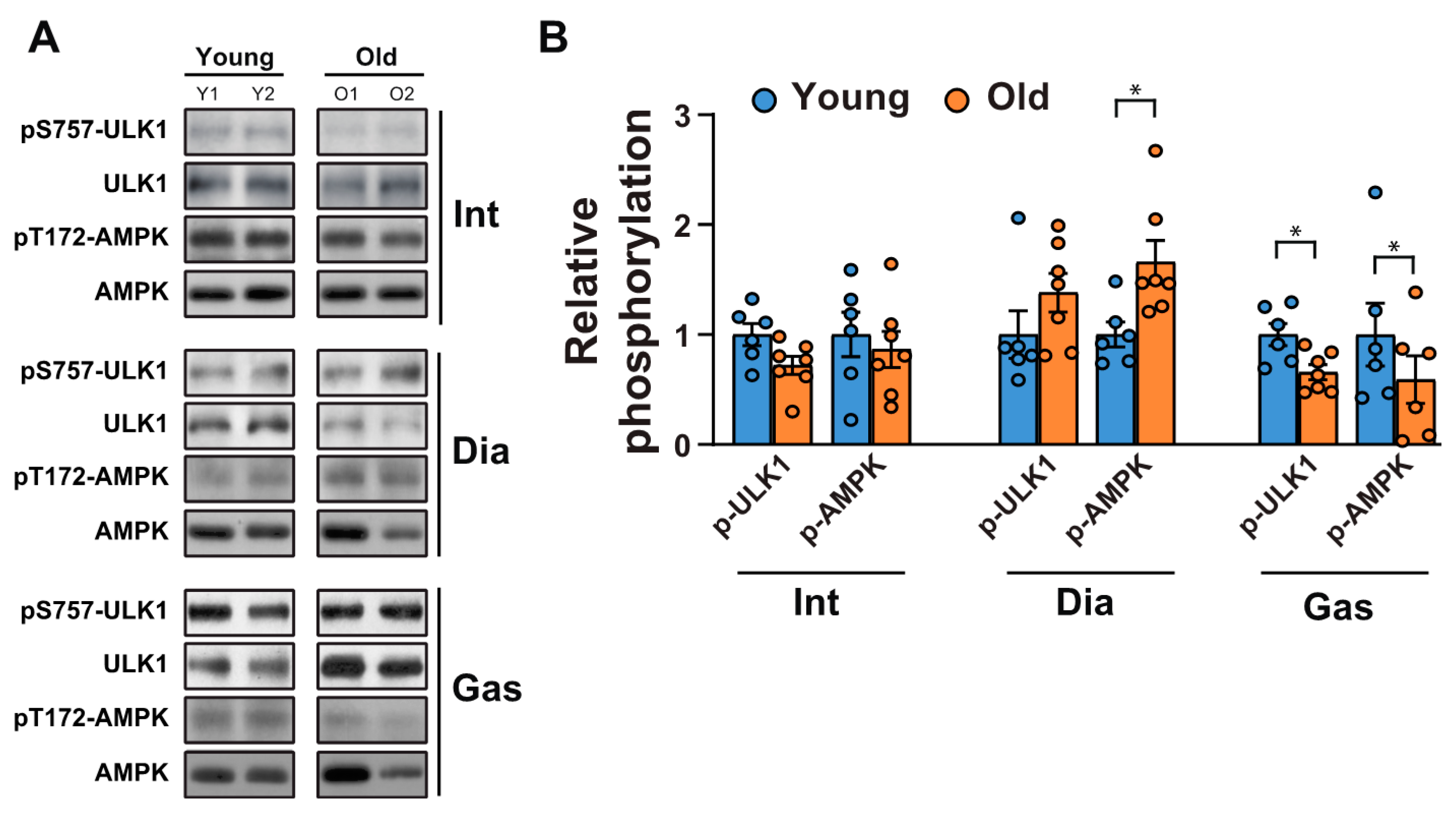Comparative Analyses of mTOR/Akt and Muscle Atrophy-Related Signaling in Aged Respiratory and Gastrocnemius Muscles
Abstract
1. Introduction
2. Results
2.1. Comparison of the Activities of mTORC1 and Akt in Respiratory Muscles and Gastrocnemii as a Function of Age
2.2. Comparison of the Age-related Changes in Activities of FoxO1, mRNA Levels of Klf15, and Ubiquitin-related Proteinases Between the Respiratory Muscles and Gastrocnemii
2.3. Analysis of the Autophagic Flux between the Respiratory Muscles and Gastrocnemii with Age
2.4. Examination of Mitochondrial Quality Control-related Gene mRNA Levels Between Respiratory Muscles and Gastrocnemii with Age
3. Discussion
4. Materials and Methods
4.1. Antibodies, Other Reagents, and Tissues
4.2. Tissue Lysis, Immunoprecipitation, and Western Blot Analysis
4.3. RNA Isolation and Real-time Quantitative Reverse Transcription- Polymerase Chain Reaction (RT-qPCR)
4.4. Statistical Analysis
Supplementary Materials
Author Contributions
Funding
Acknowledgments
Conflicts of Interest
Abbreviations
| AMPK | AMP-activated protein kinase |
| Dia | diaphragm |
| 4EBP1 | the eukaryotic translation initiation factor 4E (eIF4E)-binding protein 1 |
| FoxO | Forkhead box protein O |
| KLFs | Kruppel-like, zinc finger transcription factors |
| Gas | gastrocnemius |
| Int | intercostal |
| IRS-1 | insulin receptor substrate-1 |
| mTOR | mammalian target of rapamycin |
| mTORC1 | mTOR complex1 |
| ULK1 | Unc-51 like autophagy activating kinase 1 |
References
- Masiero, E.; Agatea, L.; Mammucari, C.; Blaauw, B.; Loro, E.; Komatsu, M.; Metzger, D.; Reggiani, C.; Schiaffino, S.; Sandri, M. Autophagy is required to maintain muscle mass. Cell Metab. 2009, 10, 507–515. [Google Scholar] [CrossRef]
- Frontera, W.R.; Hughes, V.A.; Lutz, K.J.; Evans, W.J. A cross-sectional study of muscle strength and mass in 45- to 78-yr-old men and women. J. Appl. Physiol. (Bethesda Md. 1985) 1991, 71, 644–650. [Google Scholar] [CrossRef]
- Hughes, V.A.; Frontera, W.R.; Wood, M.; Evans, W.J.; Dallal, G.E.; Roubenoff, R.; Fiatarone Singh, M.A. Longitudinal muscle strength changes in older adults: Influence of muscle mass, physical activity, and health. J. Gerontol. A Biol. Sci. Med. Sci. 2001, 56, B209–B217. [Google Scholar] [CrossRef]
- Cheng, S.; Degens, H.; Evans, M.; Cheng, S.M.; Selanne, H.; Rittweger, J.; Heinonen, A.; Suominen, H.; Strandberg, T.; Alen, M.; et al. What Makes a 97-Year-Old Man Cycle 5000 km a Year? Gerontology 2016, 62, 508–512. [Google Scholar] [CrossRef]
- Park, S.S.; Seo, Y.K.; Kwon, K.S. Sarcopenia targeting with autophagy mechanism by exercise. BMB Rep. 2019, 52, 64–69. [Google Scholar] [CrossRef]
- Goodpaster, B.H.; Park, S.W.; Harris, T.B.; Kritchevsky, S.B.; Nevitt, M.; Schwartz, A.V.; Simonsick, E.M.; Tylavsky, F.A.; Visser, M.; Newman, A.B. The loss of skeletal muscle strength, mass, and quality in older adults: The health, aging and body composition study. J. Gerontol. A Biol. Sci. Med. Sci. 2006, 61, 1059–1064. [Google Scholar] [CrossRef]
- Cohen, S.; Nathan, J.A.; Goldberg, A.L. Muscle wasting in disease: Molecular mechanisms and promising therapies. Nat. Rev. Drug Discov. 2015, 14, 58–74. [Google Scholar] [CrossRef]
- Bentzinger, C.F.; Romanino, K.; Cloetta, D.; Lin, S.; Mascarenhas, J.B.; Oliveri, F.; Xia, J.; Casanova, E.; Costa, C.F.; Brink, M.; et al. Skeletal muscle-specific ablation of raptor, but not of rictor, causes metabolic changes and results in muscle dystrophy. Cell Metab. 2008, 8, 411–424. [Google Scholar] [CrossRef] [PubMed]
- Laplante, M.; Sabatini, D.M. mTOR signaling in growth control and disease. Cell 2012, 149, 274–293. [Google Scholar] [CrossRef] [PubMed]
- Sandri, M.; Sandri, C.; Gilbert, A.; Skurk, C.; Calabria, E.; Picard, A.; Walsh, K.; Schiaffino, S.; Lecker, S.H.; Goldberg, A.L. Foxo transcription factors induce the atrophy-related ubiquitin ligase atrogin-1 and cause skeletal muscle atrophy. Cell 2004, 117, 399–412. [Google Scholar] [CrossRef]
- Zhou, J.; Chong, S.Y.; Lim, A.; Singh, B.K.; Sinha, R.A.; Salmon, A.B.; Yen, P.M. Changes in macroautophagy, chaperone-mediated autophagy, and mitochondrial metabolism in murine skeletal and cardiac muscle during aging. Aging (Albany N.Y.) 2017, 9, 583–599. [Google Scholar] [CrossRef]
- Marchand, E.; Decramer, M. Respiratory muscle function and drive in chronic obstructive pulmonary disease. Clin. Chest Med. 2000, 21, 679–692. [Google Scholar] [CrossRef]
- Nakanishi, N.; Oto, J.; Ueno, Y.; Nakataki, E.; Itagaki, T.; Nishimura, M. Change in diaphragm and intercostal muscle thickness in mechanically ventilated patients: A prospective observational ultrasonography study. J. Intensive Care 2019, 7, 56. [Google Scholar] [CrossRef] [PubMed]
- Sharma, G.; Goodwin, J. Effect of aging on respiratory system physiology and immunology. Clin. Interv. 2006, 1, 253–260. [Google Scholar] [CrossRef] [PubMed]
- Lowery, E.M.; Brubaker, A.L.; Kuhlmann, E.; Kovacs, E.J. The aging lung. Clin. Interv. Aging 2013, 8, 1489–1496. [Google Scholar] [CrossRef] [PubMed]
- Gosselin, L.E.; Johnson, B.D.; Sieck, G.C. Age-related changes in diaphragm muscle contractile properties and myosin heavy chain isoforms. Am. J. Respir. Crit. Care Med. 1994, 150, 174–178. [Google Scholar] [CrossRef]
- Greising, S.M.; Mantilla, C.B.; Gorman, B.A.; Ermilov, L.G.; Sieck, G.C. Diaphragm muscle sarcopenia in aging mice. Exp. Gerontol. 2013, 48, 881–887. [Google Scholar] [CrossRef]
- Greising, S.M.; Ermilov, L.G.; Sieck, G.C.; Mantilla, C.B. Ageing and neurotrophic signalling effects on diaphragm neuromuscular function. J. Physiol. 2015, 593, 431–440. [Google Scholar] [CrossRef]
- Elliott, J.E.; Greising, S.M.; Mantilla, C.B.; Sieck, G.C. Functional impact of sarcopenia in respiratory muscles. Respir. Physiol. Neurobiol. 2016, 226, 137–146. [Google Scholar] [CrossRef]
- Elliott, J.E.; Omar, T.S.; Mantilla, C.B.; Sieck, G.C. Diaphragm muscle sarcopenia in Fischer 344 and Brown Norway rats. Exp. Physiol. 2016, 101, 883–894. [Google Scholar] [CrossRef]
- Greising, S.M.; Mantilla, C.B.; Medina-Martinez, J.S.; Stowe, J.M.; Sieck, G.C. Functional impact of diaphragm muscle sarcopenia in both male and female mice. Am. J. Physiol. Lung Cell. Mol. Physiol. 2015, 309, L46–L52. [Google Scholar] [CrossRef] [PubMed]
- Guerri, R.; Gayete, A.; Balcells, E.; Ramirez-Sarmiento, A.; Vollmer, I.; Garcia-Aymerich, J.; Gea, J.; Orozco-Levi, M. Mass of intercostal muscles associates with risk of multiple exacerbations in COPD. Respir. Med. 2010, 104, 378–388. [Google Scholar] [CrossRef]
- Yoon, M.S. The Role of Mammalian Target of Rapamycin (mTOR) in Insulin Signaling. Nutrients 2017, 9, 1176. [Google Scholar] [CrossRef] [PubMed]
- O’Neill, B.T.; Bhardwaj, G.; Penniman, C.M.; Krumpoch, M.T.; Suarez Beltran, P.A.; Klaus, K.; Poro, K.; Li, M.; Pan, H.; Dreyfuss, J.M.; et al. FoxO Transcription Factors Are Critical Regulators of Diabetes-Related Muscle Atrophy. Diabetes 2019, 68, 556–570. [Google Scholar] [CrossRef]
- Shimizu, N.; Yoshikawa, N.; Ito, N.; Maruyama, T.; Suzuki, Y.; Takeda, S.; Nakae, J.; Tagata, Y.; Nishitani, S.; Takehana, K.; et al. Crosstalk between glucocorticoid receptor and nutritional sensor mTOR in skeletal muscle. Cell Metab. 2011, 13, 170–182. [Google Scholar] [CrossRef] [PubMed]
- Gumucio, J.P.; Mendias, C.L. Atrogin-1, MuRF-1, and sarcopenia. Endocrine 2013, 43, 12–21. [Google Scholar] [CrossRef]
- Taillandier, D.; Polge, C. Skeletal muscle atrogenes: From rodent models to human pathologies. Biochimie 2019, 166, 251–269. [Google Scholar] [CrossRef]
- Kim, J.; Kundu, M.; Viollet, B.; Guan, K.L. AMPK and mTOR regulate autophagy through direct phosphorylation of Ulk1. Nat. Cell Biol. 2011, 13, 132–141. [Google Scholar] [CrossRef]
- Shaw, R.J.; Kosmatka, M.; Bardeesy, N.; Hurley, R.L.; Witters, L.A.; DePinho, R.A.; Cantley, L.C. The tumor suppressor LKB1 kinase directly activates AMP-activated kinase and regulates apoptosis in response to energy stress. Proc. Natl. Acad. Sci. USA 2004, 101, 3329–3335. [Google Scholar] [CrossRef]
- Lesmana, R.; Sinha, R.A.; Singh, B.K.; Zhou, J.; Ohba, K.; Wu, Y.; Yau, W.W.; Bay, B.H.; Yen, P.M. Thyroid Hormone Stimulation of Autophagy Is Essential for Mitochondrial Biogenesis and Activity in Skeletal Muscle. Endocrinology 2016, 157, 23–38. [Google Scholar] [CrossRef]
- Frank, M.; Duvezin-Caubet, S.; Koob, S.; Occhipinti, A.; Jagasia, R.; Petcherski, A.; Ruonala, M.O.; Priault, M.; Salin, B.; Reichert, A.S. Mitophagy is triggered by mild oxidative stress in a mitochondrial fission dependent manner. Biochim. Biophys. Acta 2012, 1823, 2297–2310. [Google Scholar] [CrossRef] [PubMed]
- Youle, R.J.; van der Bliek, A.M. Mitochondrial fission, fusion, and stress. Science 2012, 337, 1062–1065. [Google Scholar] [CrossRef] [PubMed]
- Blais, E.M.; Rawls, K.D.; Dougherty, B.V.; Li, Z.I.; Kolling, G.L.; Ye, P.; Wallqvist, A.; Papin, J.A. Reconciled rat and human metabolic networks for comparative toxicogenomics and biomarker predictions. Nat. Commun. 2017, 8, 14250. [Google Scholar] [CrossRef] [PubMed]
- Martens, G.A. Species-Related Differences in the Proteome of Rat and Human Pancreatic Beta Cells. J. Diabetes Res. 2015, 2015, 549818. [Google Scholar] [CrossRef]
- Uchida, Y.; Zhang, Z.; Tachikawa, M.; Terasaki, T. Quantitative targeted absolute proteomics of rat blood-cerebrospinal fluid barrier transporters: Comparison with a human specimen. J. Neurochem. 2015, 134, 1104–1115. [Google Scholar] [CrossRef]
- Shavlakadze, T.; Morris, M.; Fang, J.; Wang, S.X.; Zhu, J.; Zhou, W.; Tse, H.W.; Mondragon-Gonzalez, R.; Roma, G.; Glass, D.J. Age-Related Gene Expression Signature in Rats Demonstrate Early, Late, and Linear Transcriptional Changes from Multiple Tissues. Cell Rep. 2019, 28, 3263–3273. [Google Scholar] [CrossRef]
- Raught, B.; Peiretti, F.; Gingras, A.C.; Livingstone, M.; Shahbazian, D.; Mayeur, G.L.; Polakiewicz, R.D.; Sonenberg, N.; Hershey, J.W. Phosphorylation of eucaryotic translation initiation factor 4B Ser422 is modulated by S6 kinases. EMBO J. 2004, 23, 1761–1769. [Google Scholar] [CrossRef]
- Raben, N.; Hill, V.; Shea, L.; Takikita, S.; Baum, R.; Mizushima, N.; Ralston, E.; Plotz, P. Suppression of autophagy in skeletal muscle uncovers the accumulation of ubiquitinated proteins and their potential role in muscle damage in Pompe disease. Hum. Mol. Genet. 2008, 17, 3897–3908. [Google Scholar] [CrossRef]
- Mizushima, N.; Levine, B. Autophagy in mammalian development and differentiation. Nat. Cell Biol. 2010, 12, 823–830. [Google Scholar] [CrossRef]
- He, W.A.; Berardi, E.; Cardillo, V.M.; Acharyya, S.; Aulino, P.; Thomas-Ahner, J.; Wang, J.; Bloomston, M.; Muscarella, P.; Nau, P.; et al. NF-kappaB-mediated Pax7 dysregulation in the muscle microenvironment promotes cancer cachexia. J. Clin. Investig. 2013, 123, 4821–4835. [Google Scholar] [CrossRef]
- Bergen, W.G. Measuring in vivo intracellular protein degradation rates in animal systems. J. Anim. Sci. 2008, 86, E3–E12. [Google Scholar] [CrossRef] [PubMed]
- Bozinovski, S.; Vlahos, R.; Hansen, M.; Liu, K.; Anderson, G.P. Akt in the pathogenesis of COPD. Int. J. Chron. Obstruct. Pulmon. Dis. 2006, 1, 31–38. [Google Scholar] [CrossRef] [PubMed]
- Xu, F.; Lin, J.; Cui, W.; Kong, Q.; Li, Q.; Li, L.; Wei, Y.; Dong, J. Scutellaria baicalensis Attenuates Airway Remodeling via PI3K/Akt/NF-kappaB Pathway in Cigarette Smoke Mediated-COPD Rats Model. Evid. Based Complement. Alternat. Med. 2018, 2018, 1281420. [Google Scholar] [CrossRef] [PubMed]
- Miao, L.; Gao, Z.; Huang, F.; Huang, S.; Zhang, R.; Ma, D.; Wu, Q.; Li, F.; Chen, H.; Wang, J. Erythromycin enhances the anti-inflammatory activity of budesonide in COPD rat model. Int. J. Clin. Exp. Med. 2015, 8, 22217–22226. [Google Scholar] [PubMed]
- Feng, F.; Du, J.; Meng, Y.; Guo, F.; Feng, C. Louqin Zhisou Decoction Inhibits Mucus Hypersecretion for Acute Exacerbation of Chronic Obstructive Pulmonary Disease Rats by Suppressing EGFR-PI3K-AKT Signaling Pathway and Restoring Th17/Treg Balance. Evid. Based Complement. Alternat. Med. 2019, 2019, 6471815. [Google Scholar] [CrossRef] [PubMed]
- Kim, S.Y.; Lee, J.H.; Huh, J.W.; Ro, J.Y.; Oh, Y.M.; Lee, S.D.; An, S.; Lee, Y.S. Cigarette smoke induces Akt protein degradation by the ubiquitin-proteasome system. J. Biol. Chem. 2011, 286, 31932–31943. [Google Scholar] [CrossRef]
- Su, J.; Li, J.; Lu, Y.; Li, N.; Li, P.; Wang, Z.; Wu, W.; Liu, X. The rat model of COPD skeletal muscle dysfunction induced by progressive cigarette smoke exposure: A pilot study. BMC Pulm. Med. 2020, 20, 74. [Google Scholar] [CrossRef]
- Romanello, V.; Sandri, M. Mitochondria quality control and muscle mass maintenance. Front. Physiol. 2016, 6. [Google Scholar] [CrossRef]
- Lee, E.K.; Chung, K.W.; Kim, Y.R.; Ha, S.; Kim, S.D.; Kim, D.H.; Jung, K.J.; Lee, B.; Im, E.; Yu, B.P.; et al. Small RNAs induce the activation of the pro-inflammatory TLR7 signaling pathway in aged rat kidney. Aging Cell 2017, 16, 1026–1034. [Google Scholar] [CrossRef]





| Molecular Signalings | Protein | Intercostal/Diaphragm | Gastrocnemius |
|---|---|---|---|
| mTORC1/Akt/FoxO1 | mTOR | -/- | - |
| pS2448-mTOR | -/decrease | decrease | |
| pS235/236-rpS6 | -/- | - | |
| pS65-4EBP1 | -/- | decrease | |
| pS473-Akt | -/increase | - | |
| pS256-FoxO1 | -/increase | - | |
| Autophagy initiation | pS757-ULK1 | -/- | decrease |
| pT172-AMPK | -/increase | decrease | |
| Ubiquitin-related proteolysis | Klf15 | -/increase | - |
| MuRF1 | -/- | - | |
| Atrogin-1 | -/- | - | |
| Autophagic flux | P62 | -/- | increase |
| LC3BII | -/- | increase | |
| Mitochondrial quality control | Pgc1α | -/- | decrease |
| CoxII | -/- | decrease | |
| Drp1 | -/- | - | |
| Pink1 | -/- | - |
| Primer Symbol | Sequence of Primer (5ʹ–3ʹ) |
|---|---|
| rGapdh_F | GACATGCCGCCTGGAGAAAC |
| rGapdh_R | AGCCCAGGATGCCCTTTAGT |
| rKlf15_F | CTGCAGCAAGATGTACACCAA |
| rKlf15_R | TCATCTGAGCGTGAAAACCTC |
| rDrp1_F | AAGAAAAGAAGCGGCTGACA |
| rDrp1_R | GCCAGTCTTCACACAAGCAA |
| rPink1_F | AGCGAAGCCATCTTAAGCAA |
| rPink1_R | GCCTCGGTGACAGCTAAGTC |
| rPgc1α_F | ATGTGTCGCCTTCTTGCTCT |
| rPgc1α_R | ATCTACTGCCTGGGGACCTT |
| rCoxII_F | CGCCACATCACCAATCATAG |
| rCoxII_R | GAATTCGTAGGGAGGGAAGG |
| r18S rRNA_F | AAACGGCTACCACATCCAAG |
| r18S rRNA_R | CCTCCAATGGATCCTCGTTA |
© 2020 by the authors. Licensee MDPI, Basel, Switzerland. This article is an open access article distributed under the terms and conditions of the Creative Commons Attribution (CC BY) license (http://creativecommons.org/licenses/by/4.0/).
Share and Cite
Kim, K.W.; Cho, H.-J.; Khaliq, S.A.; Son, K.H.; Yoon, M.-S. Comparative Analyses of mTOR/Akt and Muscle Atrophy-Related Signaling in Aged Respiratory and Gastrocnemius Muscles. Int. J. Mol. Sci. 2020, 21, 2862. https://doi.org/10.3390/ijms21082862
Kim KW, Cho H-J, Khaliq SA, Son KH, Yoon M-S. Comparative Analyses of mTOR/Akt and Muscle Atrophy-Related Signaling in Aged Respiratory and Gastrocnemius Muscles. International Journal of Molecular Sciences. 2020; 21(8):2862. https://doi.org/10.3390/ijms21082862
Chicago/Turabian StyleKim, Kun Woo, Hye-Jeong Cho, Sana Abdul Khaliq, Kuk Hui Son, and Mee-Sup Yoon. 2020. "Comparative Analyses of mTOR/Akt and Muscle Atrophy-Related Signaling in Aged Respiratory and Gastrocnemius Muscles" International Journal of Molecular Sciences 21, no. 8: 2862. https://doi.org/10.3390/ijms21082862
APA StyleKim, K. W., Cho, H.-J., Khaliq, S. A., Son, K. H., & Yoon, M.-S. (2020). Comparative Analyses of mTOR/Akt and Muscle Atrophy-Related Signaling in Aged Respiratory and Gastrocnemius Muscles. International Journal of Molecular Sciences, 21(8), 2862. https://doi.org/10.3390/ijms21082862





